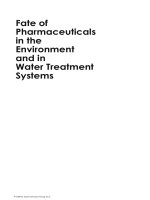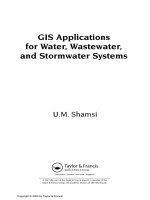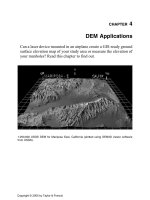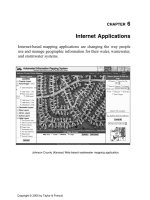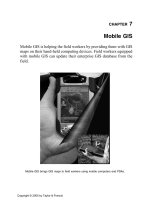GIS Applications for Water, Wastewater, and Stormwater Systems - Chapter 1 potx
Bạn đang xem bản rút gọn của tài liệu. Xem và tải ngay bản đầy đủ của tài liệu tại đây (3.81 MB, 45 trang )
U.M. Shamsi
GIS Applications
for Water, Wastewater,
and Stormwater Systems
Boca Raton London New York Singapore
A CRC title, part of the Taylor & Francis imprint, a member of the
Taylor & Francis Group, the academic division of T&F Informa plc.
Copyright © 2005 by Taylor & Francis
This book contains information obtained from authentic and highly regarded sources. Reprinted material
is quoted with permission, and sources are indicated. A wide variety of references are listed. Reasonable
efforts have been made to publish reliable data and information, but the author and the publisher cannot
assume responsibility for the validity of all materials or for the consequences of their use.
Neither this book nor any part may be reproduced or transmitted in any form or by any means, electronic
or mechanical, including photocopying, microfilming, and recording, or by any information storage or
retrieval system, without prior permission in writing from the publisher.
The consent of CRC Press does not extend to copying for general distribution, for promotion, for creating
new works, or for resale. Specific permission must be obtained in writing from CRC Press for such
copying.
Direct all inquiries to CRC Press, 2000 N.W. Corporate Blvd., Boca Raton, Florida 33431.
Trademark Notice:
Product or corporate names may be trademarks or registered trademarks, and are
used only for identification and explanation, without intent to infringe.
Visit the CRC Press Web site at www.crcpress.com
© 2005 by CRC Press
No claim to original U.S. Government works
International Standard Book Number 0-8493-2097-6
Library of Congress Card Number 2004057108
Printed in the United States of America 1 2 3 4 5 6 7 8 9 0
Printed on acid-free paper
Library of Congress Cataloging-in-Publication Data
Shamsi, U. M. (Uzair M.)
GIS applications for water, wastewater, and stormwater systems / U.M. Shamsi.
p. cm.
Includes bibliographical references and index.
ISBN 0-8493-2097-6 (alk. paper)
1. Water—Distribution. 2. Sewage disposal. 3. Runoff—Management. 4. Geographic
information systems. I. Title.
TD482.S53 2005
628.1 dc22 2004057108
2097 disclaimer.fm Page 1 Wednesday, October 20, 2004 7:08 AM
Copyright © 2005 by Taylor & Francis
Dedication
Dedicated to my beloved wife, Roshi, and my children,
Maria, Adam, and Harris
2097_FM.fm Page 3 Thursday, December 9, 2004 11:56 AM
Copyright © 2005 by Taylor & Francis
Preface
To fully appreciate the benefits of GIS applications consider the following
hypothetical scenario. On March 10, 2004, following a heavy storm event, a sewer
customer calls the Sewer Authority of the City of Cleanwater to report minor
basement flooding without any property damage. An Authority operator immediately
starts the GIS and enters the customer address. GIS zooms to the resident property
and shows all the sewers and manholes in the area. The operator queries the inspec-
tion data for a sewer segment adjacent to the customer property and finds that a
mini movie of the closed-circuit television (CCTV) inspection dated July 10, 1998,
is available. The operator plays the movie and sees light root growth in the segment.
A query of the maintenance history for that segment indicates that it has not been
cleaned since April 5, 1997. This information indicates that the roots were never
cleaned and have probably grown to “heavy” status. The operator highlights the
sewer segment, launches the work order module, and completes a work order form
for CCTV inspection and root removal, if necessary. The export button saves the
work order form and a map of the property and adjacent sewers in a PDF file. The
operator immediately sends the PDF file by e-mail to the Authority’s sewer cleaning
contractor. The entire session from the time the customer called the Authority office
took about 30 min. The operator does not forget to call the customer to tell him that
a work order has been issued to study the problem. This book presents the methods
and examples required to develop applications such as this.
The days of the slide rule are long gone. Word processors are no longer consid-
ered cutting-edge technology. We are living in an information age that requires us
to be more than visionaries who can sketch an efficient infrastructure plan. This
tech-heavy society expects us to be excellent communicators who can keep all the
stakeholders — the public, the regulators, or the clients — “informed.” New infor-
mation and decision support systems have been developed to help us to be good
communicators. GIS is one such tool that helps us to communicate geographic or
spatial information. The real strength of GIS is its ability to integrate information.
GIS helps decision makers by pulling together crucial bits and pieces of information
as a whole and showing them the “big picture.” In the past 10 years, the number of
GIS users has increased substantially. Many of us are using GIS applications on the
Internet and on wireless devices without even knowing that we are using a GIS.
Experts believe that in the near future, most water, wastewater, and stormwater
system professionals will be using the GIS in the same way they are now using a
word processor or spreadsheet. Except for the computer itself, no technology has
so revolutionized the water industry. The time has come for all the professionals
involved in the planning, design, construction, and operation of water, wastewater,
and stormwater systems to enter one of the most promising and exciting technologies
of the millennium in their profession — GIS applications.
According to some estimates, more than 80% of all the information used by water and
sewer utilities is geographically referenced.
2097_FM.fm Page 5 Thursday, December 9, 2004 11:56 AM
Copyright © 2005 by Taylor & Francis
This book was inspired from a continuing education course that the author has
been teaching since 1998 for the American Society of Civil Engineers (ASCE).
Entitled ‘‘GIS Applications in Water, Wastewater and Stormwater Systems,” the
seminar course has been attended by hundreds of water, wastewater, and stormwater
professionals in major cities of the United States. Many models, software, examples,
and case studies described in the book (especially those from Pennsylvania) are
based on the GIS projects worked on or managed by the author himself.
This is my second GIS book for water, wastewater, and stormwater systems. The
first book,
GIS Tools for Water, Wastewater, and Stormwater Systems
, published by
American Society of Civil Engineers (ASCE) Press in 2002, was a huge success.
The first printing was sold out, and the book achieved ASCE Press’s best-seller
status within months of publication. Whereas the first book focused on GIS basics
and software and data tools to develop GIS applications, this second book focuses
on the practical applications of those tools. Despite the similarity of the titles, both
books cover different topics and can be read independent of each other.
STYLE OF THE BOOK
This book has been written using the recommendations of the Accreditation
Board for Engineering and Technology (ABET) of the U.S. and the American Society
of Civil Engineers’ (ASCE) Excellence in Civil Engineering Education (ExCEEd)
program. Both of these organizations recommend performance- (or outcome-) based
learning in which the learning objectives of each lecture (or chapter) are clearly
stated up front, and the learning is measured in terms of achieving these learning
objectives. Each chapter of this book accordingly starts with learning objectives for
that chapter and ends with a chapter summary and questions. Most technical books
are written using the natural human teaching style called
deductive
, in which prin-
ciples are presented before the applications. In this book, an attempt has been made
to organize the material in the natural human learning style called
inductive
, in which
examples are presented before the principles. For example, in most chapters, case
studies are presented before the procedures are explained. The book has numerous
maps and illustrations that should cater well to the learning styles of “visual learners”
— GIS, after all is regarded as a visual language.
The primary learning objective of this book is to document GIS applications for water,
wastewater, and stormwater systems. This book will show you how to use GIS to make tasks
easier to do and increase productivity, and hence, save time and money in your business.
ORGANIZATION OF THE BOOK
There are 17 chapters in this book, organized as follows:
• Chapter 1, GIS Applications: Describes why GIS applications are important and
how they are created
2097_FM.fm Page 6 Thursday, December 9, 2004 11:56 AM
Copyright © 2005 by Taylor & Francis
• Chapter 2, Needs Analysis: Explains how to avoid potential pitfalls of GIS imple-
mentation by starting with a needs analysis study
The next five chapters describe four GIS-related technologies that are very
beneficial in developing GIS applications:
• Chapter 3, Remote Sensing Applications: Shows how to use satellite imagery in
GIS applications
• Chapter 4, DEM Applications: Describes the methods of incorporating digital
elevation model (DEM) data
• Chapter 5, GPS Applications: Discusses how to benefit from global positioning
system (GPS) technology
• Chapter 6, Internet Applications: Explains the applications of Internet technology
in serving GIS maps on the Internet
• Chapter 7, Mobile GIS: Provides information on using GIS in the field for inspec-
tion and maintenance work
The GIS applications that are of particular importance to water industry profes-
sionals are: Mapping, Monitoring, Modeling, and Maintenance. These four
M
s define
some of the most important activities for efficient management of water, wastewater,
and stormwater systems, and are referred to as the “4M applications” in this book.
The next ten chapters focus on these four
M
s.
• Chapter 8, Mapping: Describes how to create the first
M
of the 4M applications
• Chapter 9, Mapping Applications: Describes examples of the first
M
of the 4M
applications
• Chapter 10, Monitoring Applications: Describes the applications of the second
M
of the 4M applications
• Chapter 11, Modeling Applications: Describes the applications of the third
M
of
the 4M applications
• Chapter 12, Water Models: Describes examples of the third
M
of the 4M appli-
cations for modeling water distribution systems
• Chapter 13, Sewer Models: Describes examples of the third
M
of the 4M appli-
cations for modeling sewage collection systems
• Chapter 14, AM/FM/GIS Applications: Describes automated mapping/facilities
management/geographic information system (AM/FM/GIS) software tools for
implementing the fourth
M
of the 4M applications
• Chapter 15, Maintenance Applications: Describes the applications of the fourth
M
of the 4M applications
• Chapter 16, Security Planning and Vulnerability Assessment: Discusses GIS appli-
cations for protecting water and wastewater systems against potential terrorist
attacks
• Chapter 17, Applications Sampler: Presents a collection of recent case studies
from around the world
2097_FM.fm Page 7 Thursday, December 9, 2004 11:56 AM
Copyright © 2005 by Taylor & Francis
Acknowledgments
Case studies presented in Chapter 17, Applications Sampler, were written spe-
cially for publication in this book by 18 GIS and water industry experts from 6
countries (Belgium, Bulgaria, Czech Republic, Denmark, Spain and the United States)
in response to my call for case studies distributed to various Internet discussion
forums. I thank these case study authors for their contributions to this book:
• Bart Reynaert, Rene Horemans, and Patrick Vercruyssen of Pidpa, Belgium
• Carl W. Chen and Curtis Loeb of Systech Engineering, Inc., San Ramon, California
• Dean Trammel, Tucson Water, Tucson, Arizona
• Ed Bradford, Roger Watson, Eric Mann, Jenny Konwinski of Metropolitan
Sewerage District of Buncombe County, North Carolina
• Eric Fontenot of DHI, Inc., Hørsholm, Denmark
• Milan Suchanek and Tomas Metelka of Sofiyska Voda A.D., Sofia, Bulgaria
• Peter Ingeduld, Zdenek Svitak, and Josef Drbohlav of Praûská vodohospodáská
spolenost a.s. (Prague stockholding company), Prague, Czech Republic
• Hugo Bartolin and Fernando Martinez of Polytechnic University of Valencia,
Spain
I also thank the following organizations and companies for providing infor-
mation for this book: American Society of Civil Engineers, American Water Works
Association, Azteca Systems,
CE Magazine
, CH2M Hill, Chester Engineers, Compu-
tational Hydraulics International, Danish Hydraulic Institute (DHI), Environmental
Systems Research Institute,
Geospatial Solutions Magazine
,
GEOWorld Magazine
,
Haestad Methods, Hansen Information Technology,
Journal of the American Water
Resources Association
,
Journal of the American Water Works Association
, MWH Soft,
Professional Surveyor Magazine
, USFilter,
Water Environment Federation, and Water
Environment & Technology Magazine
. Some information presented in this book is
based on my collection of papers and articles published in peer-reviewed journals,
trade magazines, conference proceedings, and the Internet. The authors and organiza-
tions of these publications are too numerous to be thanked individually, so I thank
them all collectively without mentioning their names. Their names are, of course,
included in the Reference section.
Finally, I would like to thank you for buying the book. I hope you will find the
book useful in maximizing the use of GIS in your organization to make things easier
to do, increase productivity, and save time and money.
2097_FM.fm Page 9 Thursday, December 9, 2004 11:56 AM
Copyright © 2005 by Taylor & Francis
About the Author
Uzair (Sam) M. Shamsi, Ph.D., P.E., DEE
is director of
the GIS and Information Management Technology division
of Chester Engineers, Pittsburgh, Pennsylvania, and an
adjunct assistant professor at the University of Pittsburgh,
where he teaches GIS and hydrology courses. His areas of
specialization include GIS applications and hydrologic and
hydraulic (H&H) modeling. He has been continuing
education instructor for the American Society of Civil
Engineers (ASCE) and an Environmental Systems Research
Institute (ESRI)-authorized ArcView
®
GIS instructor since
1998. He has taught GIS courses to more than 500
professionals throughout the United States, including a course on “GIS Applications
in Water, Wastewater, and Stormwater Systems” for ASCE. Sam earned his Ph.D.
in civil engineering from the University of Pittsburgh in 1988. He has 20 years of
GIS and water and wastewater engineering experience in teaching, research, and
consulting. His accomplishments include more than 120 projects and over 100
lectures and publications, mostly in GIS applications. His previous book,
GIS Tools
for Water, Wastewater, and Stormwater Systems
, was an ASCE Press best seller. He
is the recipient of the ASCE’s Excellence in Civil Engineering Education (EXCEED)
training and is a licensed professional engineer in Pennsylvania, Ohio, and West
Virginia. In addition to ASCE, he is a member of the American Water Resources
Association, the Water Environment Foundation, and the American Water Works
Association.
E-mail:
Web site: www.GISApplications.com
2097_FM.fm Page 11 Thursday, December 9, 2004 11:56 AM
Copyright © 2005 by Taylor & Francis
GIS is an instrument for implementing geographic thinking
Jack Dangermond (1998)
Iron rusts from disuse; water loses its purity from stagnation and in cold weather
becomes frozen; even so does inaction sap the vigors of the mind.
Leonardo da Vinci (1452–1519)
Life is like a sewer
…
what you get out of it depends on what you put into it.
Tom Lehrer (1928–)
Times of general calamity and confusion create great minds. The purest ore is
produced from the hottest furnace, and the brightest thunderbolt is elicited from the
darkest storms.
Charles Caleb Colton (1780–1832)
2097_FM.fm Page 13 Thursday, December 9, 2004 11:56 AM
Copyright © 2005 by Taylor & Francis
Contents
Chapter 1
GIS Applications
Learning Objective
Major Topics
List of Chapter Acronyms
Introduction
What Are GIS Applications?
History of GIS Applications
4M Applications
Advantages and Disadvantages of GIS Applications
Advantages
GIS Applications Save Time and Money
GIS Applications Are Critical to Sustaining GIS Departments
GIS Applications Provide the Power of Integration
GIS Applications Offer a Decision Support Framework
GIS Applications Provide Effective Communication Tools
GIS Applications Are Numerous
Disadvantages
Success Stories
San Diego
Boston
Cincinnati
Knoxville
Dover
Charlotte
Albany County
GIS Applications Around the World
Evolving GIS Applications and Trends
Future Applications and Trends
GIS Application Development Procedure
Application Programming
GIS-Based Approach
GIS Customization
Scripting
Extensions
External Programs
Application-Based Approach
Useful Web Sites
Chapter Summary
Chapter Questions
Chapter 2
Needs Analysis
Learning Objective
Major Topics
2097_FM.fm Page 15 Thursday, December 9, 2004 11:56 AM
Copyright © 2005 by Taylor & Francis
List of Chapter Acronyms
Ocean County’s Strategic Plan
Introduction
Needs Analysis Steps
Step 1. Stakeholder Identification
Step 2. Stakeholder Communication
Introductory Seminar
Work Sessions and Focus Groups
Interviews
Step 3. Resource Inventory
Step 4. Need Priorities
Step 5. System Design
Data Conversion (Mapping)
Database
Software Selection
Hardware Selection
User Interface
Step 6. Pilot Project
Step 7. Implementation Plan
Step 8. Final Presentation
Needs Analysis Examples
Pittsburgh, Pennsylvania
Borough of Ramsey, New Jersey
The City of Bloomington, Indiana
San Mateo County, California
Chapter Summary
Chapter Questions
Chapter 3
Remote Sensing Applications
Learning Objective
Major Topics
List of Chapter Acronyms
Albany County’s Remote Sensing Application
Introduction
Remote Sensing Applications
Remote Sensing Satellites
Spatial Resolution
Low-Resolution Satellite Data
Medium-Resolution Satellite Data
High-Resolution Satellite Data
High-Resolution Satellites
High-Resolution Imagery Applications
Data Sources
Digital Orthophotos
USGS Digital Orthophotos
Case Study: Draping DOQQ Imagery on DEM Data
2097_FM.fm Page 16 Thursday, December 9, 2004 11:56 AM
Copyright © 2005 by Taylor & Francis
Examples of Remote Sensing Applications
LULC Classification
Soil Moisture Mapping
Estimating Meteorological Data
Geographic Imaging and Image Processing Software
ERDAS Software Products
ERDAS Software Application Example
ArcView Image Analysis Extension
MrSID
PCI Geomatics
Blue Marble Geographics
Future Directions
Useful Web Sites
Chapter Summary
Chapter Questions
Chapter 4
DEM Applications
Learning Objective
Major Topics
List of Chapter Acronyms
Hydrologic Modeling of the Buffalo Bayou Using GIS and DEM Data
DEM Basics
DEM Applications
Three-Dimensional (3D) Visualization
DEM Resolution and Accuracy
USGS DEMs
USGS DEM Formats
National Elevation Dataset (NED)
DEM Data Availability
DEM Data Creation from Remote Sensing
Image Processing Method
Data Collection Method
LIDAR
IFSAR
DEM Analysis
Cell Threshold for Defining Streams
The D-8 Model
DEM Sinks
Stream Burning
DEM Aggregation
Slope Calculations
Software Tools
Spatial Analyst and Hydro Extension
ARC GRID Extension
IDRISI
TOPAZ
2097_FM.fm Page 17 Thursday, December 9, 2004 11:56 AM
Copyright © 2005 by Taylor & Francis
Case Studies and Examples
Watershed Delineation
Sewershed Delineation
Water Distribution System Modeling
WaterCAD Example
Useful Web Sites
Chapter Summary
Chapter Questions
Chapter 5
GPS Applications
Learning Objective
Major Topics
List of Chapter Acronyms
Stream Mapping in Iowa
GPS Basics
GPS Applications in the Water Industry
Surveying
Fleet Management
GPS Applications in GIS
GPS Survey Steps
GPS Equipment
Recreational GPS Equipment
Basic GPS Equipment
Advanced GPS Equipment
Survey Grade GPS Equipment
Useful Web Sites
Chapter Summary
Chapter Questions
Chapter 6
Internet Applications
Learning Objective
Major Topics
List of Chapter Acronyms
Dublin’s Web Map
Internet GIS
Internet Security
Internet GIS Software
Internet GIS Applications
Data Integration
Project Management
3D Visualization Applications
Case Studies
Tacoma’s Intranet and Mobile GIS
Montana’s Watershed Data Information Management System
Useful Web Sites
2097_FM.fm Page 18 Thursday, December 9, 2004 11:56 AM
Copyright © 2005 by Taylor & Francis
Chapter Summary
Chapter Questions
Chapter 7
Mobile GIS
Learning Objective
Major Topics
List of Chapter Acronyms
Mobile GIS Basics
Mobile GIS Applications
Wireless Internet Technology
GPS Integration
Useful Web Sites
Chapter Summary
Chapter Questions
Chapter 8
Mapping
Learning Objective
Major Topics
List of Chapter Acronyms
Los Angeles County’s Sewer Mapping Program
Mapping Basics
Map Types
Topology
Map Projections and Coordinate Systems
Map Scale
Data Quality
Data Errors
Map Accuracy
Map Types
Base Map
Digital Orthophotos
Planimetric Maps
Small-Scale Maps
Advantages of GIS Maps
GIS Mapping Steps
Needs Analysis
Data Collection
Data Conversion
Capturing Attributes
Capturing Graphics
Digitization
Scanning
Data Conversion Software
Data Processing
Data Preparation
Topological Structuring
2097_FM.fm Page 19 Thursday, December 9, 2004 11:56 AM
Copyright © 2005 by Taylor & Francis
Data Management
Quality Control
Map Production
Case Studies
Borough of Ramsey, New Jersey
City of Lake Elsinore, California
Allegheny County, Pennsylvania
Useful Web Sites
Chapter Summary
Chapter Questions
Chapter 9
Mapping Applications
Learning Objective
Major Topics
List of Chapter Acronyms
Customer Service Application in Gurnee
Common Mapping Functions
Thematic Mapping
Spatial Analysis
Buffers
Hyperlinks
Water System Mapping Applications
MWRA Water System Mapping Project
Service Shutoff Application
Generating Meter-Reading Routes
Map Maintenance Application
Wastewater System Mapping Applications
Public Participation with 3D GIS
Mapping the Service Laterals
Stormwater System Mapping Applications
Stormwater Permits
Chapter Summary
Chapter Questions
Chapter 10
Monitoring Applications
Learning Objective
Major Topics
List of Chapter Acronyms
Monitoring Real Time Rainfall and Stream-Flow Data in Aurora
Monitoring Basics
Remotely Sensed Rainfall Data
Satellite Rainfall Data
Radar Rainfall Data
NEXRAD Rainfall Data
NEXRAD Level III Data
Estimating Rainfall Using GIS
2097_FM.fm Page 20 Thursday, December 9, 2004 11:56 AM
Copyright © 2005 by Taylor & Francis
Radar Rainfall Application: Virtual Rain-Gauge Case Study
Flow-Monitoring Applications
SCADA Integration
NPDES-Permit Reporting Applications
Monitoring via Internet
Monitoring the Infrastructure
Useful Web Sites
Chapter Summary
Chapter Questions
Chapter 11
Modeling Applications
Learning Objectives
Major Topics
List of Chapter Acronyms
Temporal-Spatial Modeling in Westchester County
H&H Modeling
Application Methods
Interchange Method
Subbasin Parameter Estimation
Runoff Curve Number Estimation
Water Quality Modeling Data Estimation
Demographic Data Estimation
Land-Use Data Estimation
Interface Method
HEC-GEO Interface
HEC-GeoHMS
HEC-GeoRAS
Watershed Modeling System
GISHydro Modules
GISHydro Prepro
GISHydro Runoff
ArcInfo Interface with HEC Programs
Intermediate Data Management Programs
Interface Method Case Study
Integration Method
EPA’s BASINS Program
BASINS Examples
MIKE BASIN
Geo-STORM Integration
ARC/HEC-2 Integration
Integration Method Case Study
Which Linkage Method to Use?
Useful Web Sites
Chapter Summary
Chapter Questions
2097_FM.fm Page 21 Thursday, December 9, 2004 11:56 AM
Copyright © 2005 by Taylor & Francis
Chapter 12
Water Models
Learning Objective
Major Topics
List of Chapter Acronyms
City of Germantown’s Water Model
GIS Applications for Water Distribution Systems
Development of Hydraulic Models
Software Examples
EPANET
H
2
ONET
™
and H
2
OMAP
™
Demand Allocator
Skeletonizer
Tracer
WaterCAD
™
and WaterGEMS
™
MIKE NET
™
Other Programs
EPANET and ArcView Integration in Harrisburg
Mapping the Model Output Results
Network Skeletonization
Estimation of Node Demands
Demand-Estimation Case Studies
Newport News, Virginia
Round Rock, Texas
Lower Colorado River Authority, Texas
Estimation of Node Elevations
Pressure Zone Trace
Chapter Summary
Chapter Questions
Chapter 13
Sewer Models
Learning Objectives
Major Topics
List of Chapter Acronyms
MapInfo
™
and SWMM Interchange
GIS Applications for Sewer Systems
Sewer System Modeling Integration
Software Examples
SWMM
Useful SWMM Web Sites
SWMM Graphical User Interface
XP-SWMM and XP-GIS
GIS Data for SWMM
Estimating Green-Ampt Parameters Using STATSGO/SSURGO
GIS Files
GIS Applications for SWMM
2097_FM.fm Page 22 Thursday, December 9, 2004 11:56 AM
Copyright © 2005 by Taylor & Francis
AVSWMM
AVSWMM RUNOFF Extension
AVSWMM EXTRAN Extension
Task 1: Create EXTRAN input file
Task 2: Create SWMM EXTRAN output layers in
ArcViewGIS
SWMMTools
AGSWMM
PCSWMM GIS
™
SWMM and BASINS
SWMMDUET
AVsand
™
Other Sewer Models
DHI Models
MOUSE
™
MIKE SWMM
™
MOUSE GIS
™
MOUSE GM
™
InfoWorks
™
SewerCAD
™
and StormCAD
™
Sewer Modeling Case Studies
XP-SWMM and ArcInfo Application for CSO Modeling
AM/FM/GIS and SWMM Integration
SWMM and ArcInfo
™
Interface
Hydra
™
and ArcInfo
™
Interface
Useful Web Sites
Chapter Summary
Chapter Questions
Chapter 14
AM/FM/GIS Applications
Learning Objective
Major Topics
List of Chapter Acronyms
Hampton’s Wastewater Maintenance Management
Infrastructure Problem
AM/FM/GIS Basics
Automated Mapping (AM)
Facilities Management (FM)
Automated Mapping (AM)/Facilities Management (FM)
AM/FM/GIS Systems
AM/FM/GIS Software
ArcFM
Cityworks
Chapter Summary
Chapter Questions
2097_FM.fm Page 23 Friday, December 17, 2004 1:35 PM
Copyright © 2005 by Taylor & Francis
Chapter 15
Maintenance Applications
Learning Objective
Major Topics
List of Chapter Acronyms
Buncombe County’s Sewer System Inspection and Maintenance
Asset Management
GASB 34 Applications
Wet Weather Overflow Management Applications
AutoCAD Map GIS Application for CMOM
CCTV Inspection of Sewers
Convert Existing Video Tapes to Digital Files
Digitize Existing VHS Tapes
WinCan
Retrofit Tape Systems with Digital Systems
Record Directly in Digital Format
Linking Digital Movies to GIS
Video Mapping
Thematic Mapping of Inspection Data
Work Order Management
Water Main Isolation Trace
Case Studies
Isolation Trace Case Studies
Sewer System Inspections in Washington County
Sewer Rehabilitation in Baldwin
Useful Web Sites
Chapter Summary
Chapter Questions
Chapter 16
Security Planning and Vulnerability Assessment
Learning Objective
Major Topics
List of Chapter Acronyms
GIS Applications in Planning
Security Planning
Vulnerability of Water Systems
Vulnerability of Sewer Systems
GIS Applications in Vulnerability Assessment
Security Modeling Software
H
2
OMAP
™
Protector
WaterSAFE
™
VSAT
™
Security Planning Data Issues
Useful Web Sites
Chapter Summary
Chapter Questions
2097_FM.fm Page 24 Thursday, December 9, 2004 11:56 AM
Copyright © 2005 by Taylor & Francis
Chapter 17
Applications Sampler
Learning Objective
Major Topics
List of Chapter Acronyms
Drainage Area Planning in Sofia
Pipe Rating Program in Buncombe County
Water System Modeling in Tucson
Water System Modeling in the City of Truth or Consequences
Background
Building the MIKE NET Model from Various Data Sources
ArcGIS and ArcFM Integration in Belgium
Water System Master Planning in Prague
Water Quality Management in Mecklenburg County
Water Master Planning in Sueca, Spain
Chapter Summary
Chapter Questions
Appendix A
Acronyms
Appendix B
Conversion Factors
References
Index
389
2097_FM.fm Page 25 Thursday, December 9, 2004 11:56 AM
Copyright © 2005 by Taylor & Francis
CHAPTER
1
GIS Applications
Geographic Information System (GIS) is one of the most promising
and exciting technology of the decade in our profession. This book
will show you that with GIS the possibilities to manage your water,
wastewater, and stormwater systems are almost endless.
GIS applications can take you from work frustration to job satisfaction.
2097_C001.fm Page 1 Thursday, December 9, 2004 12:34 PM
Copyright © 2005 by Taylor & Francis
LEARNING OBJECTIVE
The learning objective of this chapter is to understand the importance and scope of
geographic information system (GIS) applications for water, wastewater, and storm-
water systems.
MAJOR TOPICS
• Definition of GIS applications
• History of GIS applications
• Advantages and disadvantages of GIS applications
• Evolving and future GIS applications and trends
• Methods of developing GIS applications
LIST OF CHAPTER ACRONYMS*
CAD
Computer-Aided Drafting/Computer-Aided Design
ESRI
Environmental Systems Research Institute
GIS
Geographic Information Systems
GPS
Global Positioning System
GUI
Graphical User Interface
H&H
Hydrologic and Hydraulic
LBS
Location-Based Services
PC
Personal Computer
PDA
Personal Digital Assistant
GIS
Project Nominated for OCEA Award
American Society of Civil Engineers (ASCE) awards Outstanding Civil Engineering
Achievement (OCEA) awards to projects based on their contribution to the well-being of
people and communities; resourcefulness in planning and solving design challenges;
pioneering in use of materials and methods; innovations in construction; impact on physical
environment; and beneficial effects including aesthetic value. The Adam County (Illinois)
2002 GIS Pilot Project was a nominee for the 1997 awards. This project was a 10-year,
multiparticipant (Adams County, City of Quincy, Two Rivers Regional Planning Council,
and a number of state and local agencies) project to develop an accurate, updated GIS
designed to create a more efficient local government.
INTRODUCTION
The water industry** business is growing throughout the world. For example,
the U.S. market for water quality systems and services had a total value of $103
billion in 2000. The two largest components of this business are the $31-billion
* Each chapter of this book begins with a list of frequently used acronyms in the chapter. Appendix A
provides a complete list of acronyms used in the book.
** In this book, the term
water industry
refers to water, wastewater, and stormwater systems.
2097_C001.fm Page 2 Thursday, December 9, 2004 12:34 PM
Copyright © 2005 by Taylor & Francis
public wastewater treatment market and the $29-billion water supply market (Farkas
and Berkowitz, 2001).
One of the biggest challenges in the big cities with aging water, wastewater,
and stormwater infrastructures is managing information about maintenance of
existing infrastructure and construction of new infrastructure. Many utilities tackle
infrastructure problems on a react-to-crisis basis that, despite its conventional
wisdom, may not be the best strategy. Making informed infrastructure improve-
ment decisions requires a large amount of diverse information on a continuing
basis. If information is the key to fixing infrastructure problems, the first step of any
infrastructure improvement project should be the development of an information
system.
An information system is a framework that provides answers to questions, from
a data resource. A GIS is a special type of information system in which the data
source is a database of spatially distributed features and procedures to collect, store,
retrieve, analyze, and display geographic data (Shamsi, 2002).
More
than 80% of all the information used by water and wastewater utilities is
geographically referenced.
In other words, a key element of the information used by utilities is its location
relative to other geographic features and objects. GIS technology that offers the
combined power of both geography and information systems is an ideal solution for
effective management of water industry infrastructure. Geotechnology and geospa-
tial technology are alias names of GIS technology.
The days of the slide rule are long gone. Word processors are no longer consid-
ered cutting-edge technology. We are living in the information age, which requires
us to be more than visionaries who can sketch an efficient infrastructure plan. Today’s
tech-savvy society expects us to be excellent communicators who can keep all the
stakeholders — the public, the regulators, or the clients — “informed.” New
information and decision support systems have been developed to help us become
good communicators. GIS is one such tool that helps us to communicate geo-
graphic or spatial information. In fact, a carefully designed GIS map can be worth
more than a thousand words. Sometimes the visual language of GIS allows us to
communicate without saying a single word, which is the essence of effective
communication.
WHAT ARE GIS APPLICATIONS?
An application is an applied use of a technology. For example, online shopping
is an application of Internet technology, automobile navigation is an application of
GPS technology, and printing driving-direction maps is an application of GIS tech-
nology. No matter how noble a technology is, without applied use it is just a theoretical
development. Applications bridge the gap between pure science and applied use.
Highly effective water and wastewater utilities strive for continuous operational
improvements and service excellence. GIS applications have the potential to enhance
2097_C001.fm Page 3 Thursday, December 9, 2004 12:34 PM
Copyright © 2005 by Taylor & Francis
the management of our water, wastewater, and stormwater systems and prepare them
for the operational challenges of the 21st century.
HISTORY OF GIS APPLICATIONS
GIS technology was conceived in the 1960s as a digital layering system for
coregistered overlays. Started in the mid-1960s and still operating today, Canadian
GIS is an example of one of the earliest GIS developments. Civilian GIS in the U.S.
got a jump start from the military and intelligence imagery programs of the 1960s.
The Internet was started in the 1970s by the U.S. Department of Defense to enable
computers and researchers at universities to work together. GIS technology was
conceived even before the birth of the Internet.
Just as technology has changed our lifestyles and work habits, it has also changed
GIS. Though the art of GIS has been in existence since the 1960s, the science was
restricted to skilled GIS professionals. The mid-1990s witnessed the inception of a
new generation of user-friendly desktop GIS software packages that transferred the
power of GIS technology to the average personal computer (PC) user with entry-
level computing skills. In the past decade, powerful workstations and sophisticated
software brought GIS capability to off-the-shelf PCs. Today, PC-based GIS imple-
mentations are much more affordable and have greatly reduced the cost of GIS
applications. Today’s GIS users are enjoying faster, cheaper, and easier products
than ever before, mainly because of the advent of powerful and affordable hardware
and software.
There were only a few dozen GIS software vendors before 1988 (Kindleberger,
1992); in 2001, the number had grown to more than 500. This revolution rightfully
steered the GIS industry from a focus on the technology itself toward the applications
of the technology (Jenkins, 2002). The strength of GIS software is increasing while
its learning curve is decreasing. At this time, GIS is one of the fastest growing market
sectors of the software industry and for a good reason: GIS applications are valuable
for a wide range of users, from city planners to property tax assessors, law enforcement
agencies, and utilities. Once the exclusive territory of cartographers and computer-
aided drafting (CAD) technicians, today’s GIS is infiltrating almost all areas of the
water industry.
A GIS article published in
American City and County
in 1992 predicted faster
computers and networks and that efficient database management and software will
move GIS applications from property recording, assessing, and taxing functions to
much more diverse applications during the 1990s (Kindleberger, 1992). This article
anticipated future GIS applications to be rich in their use of multimedia, images,
and sound. It expected GIS applications to become more closely linked to the 3D
world of CAD as used by architects and engineers. Almost all of the GIS applications
predicted in 1992 are now available except interacting with GIS data in a “virtual
reality” medium wearing helmets and data gloves.
GIS literature is broad due to the wide variety of areas that utilize geographic data.
Likewise, the literature describing GIS applications in the water industry is itself very
2097_C001.fm Page 4 Thursday, December 9, 2004 12:34 PM
Copyright © 2005 by Taylor & Francis
broad. However, much of this work has been in the area of natural hydrology and large-
scale, river-basin hydrology. A recent literature review conducted by Heaney et al.
(1999)
concluded that GIS applications literature exists in several distinct fields. In the
field of water resources, recent conferences focusing on urban stormwater have several
papers on GIS. Proceedings from two European conferences on urban stormwater by
Butler and Maksimovic (1998), and Seiker and Verworn (1996), have a wealth of
current information on GIS. The American Water Resources Association (AWRA) has
sponsored specialty conferences on GIS applications in water resources, such as Harlin
and Lanfear (1993) and Hallam et al. (1996). These reports have sections devoted to
urban stormwater, of which modeling is a recurring theme. The International Associ-
ation of Hydrological Sciences (IAHS) publishes the proceedings from its many con-
ferences, some of which have dealt specifically with the integration and application of
GIS and water resources management (e.g., Kovar and Nachtnebel, 1996).
In the early 1990s, not too many people were very optimistic about the future
of GIS applications. This perception was based, in part, on geographic information
technologies being relatively new at that time and still near the lower end of the
growth curve in terms of (1) applications and (2) their influence as tools on the ways
in which scientific inquiries and assessments were conducted (Goodchild, 1996). It
was felt that several challenges related to our knowledge of specific processes and
scale effects must be overcome to brighten the future of GIS applications (Wilson
et al., 2000).
GIS applications for the water industry started evolving in the late 1980s. In the
early 1990s, the water industry had started to use GIS in mapping, modeling,
facilities management, and work-order management for developing capital improve-
ment programs and operations and maintenance plans (Morgan and Polcari, 1991).
In the mid-1990s, GIS started to see wide applicability to drinking water studies.
Potential applications identified at that time included (Schock and Clement, 1995):
• GIS can provide the basis for investigating the occurrence of regulated contami-
nants for estimating the compliance cost or evaluating human health impacts.
• Mapping can be used to investigate process changes for a water utility or to
determine the effectiveness of some existing treatment such as corrosion control
or chlorination.
• GIS can assist in assessing the feasibility and impact of system expansion.
• GIS can assist in developing wellhead protection plans.
According to the American Water Works Association (AWWA), approximately
90% of the water utilities in the U.S. were using GIS technology by the end of the
year 2000.
The use of GIS as a management tool has grown since the late 20th century. In
the past 10 years, the number of GIS users has increased substantially. GIS tech-
nology has eased previously laborious procedures. Exchange of data between GIS,
CAD, supervisory control and data acquisition (SCADA), and hydrologic and
hydraulic (H&H) models is becoming much simpler. For example, delineating water-
sheds and stream networks has been simplified and the difficulty of conducting
spatial data management and model parameterization reduced (Miller et al., 2004).
2097_C001.fm Page 5 Thursday, December 9, 2004 12:34 PM
Copyright © 2005 by Taylor & Francis
